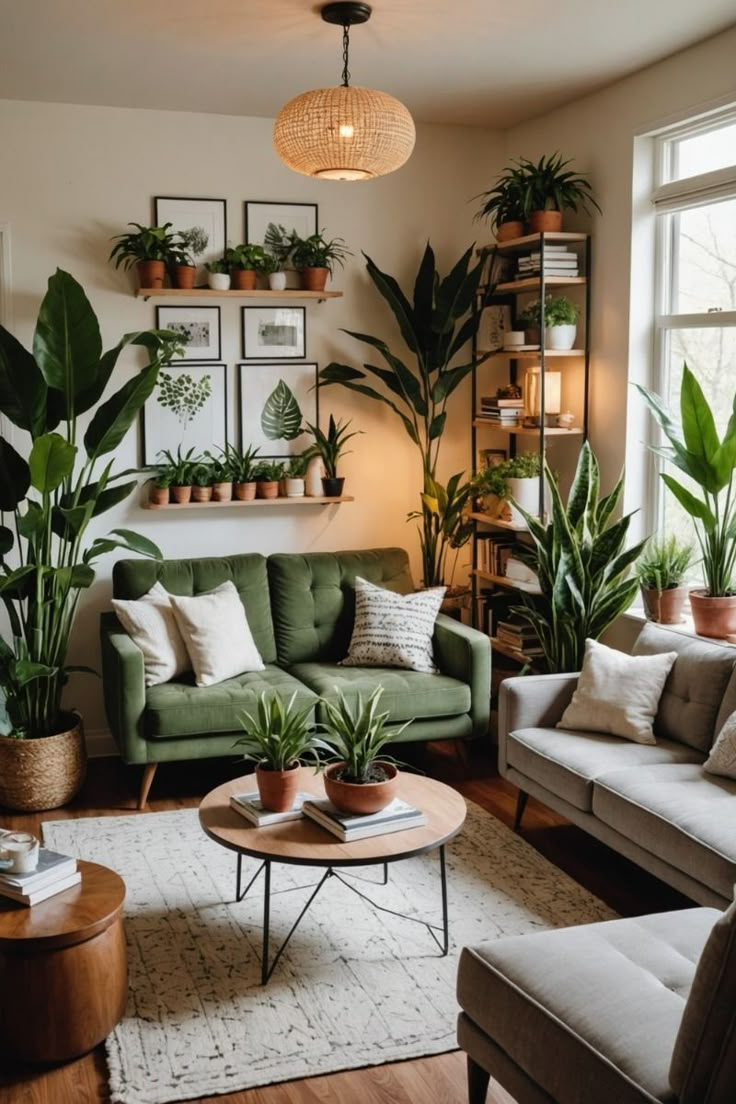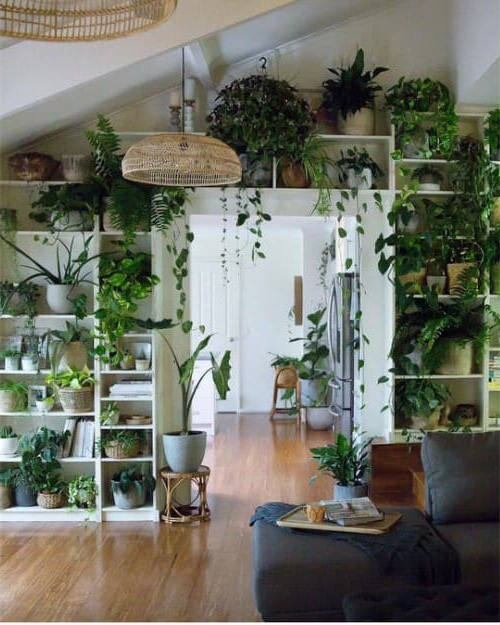Your living room deserves more than just furniture and décor. Adding the right plants can transform the space, bringing life, color, and fresh air into your home. But choosing which plants will thrive in your specific living room environment isn’t always straightforward. What if you could have a lush, thriving indoor garden without the guesswork? Let’s explore how to select the perfect plants that will not only survive but truly flourish in your living room.
Living rooms are more than just spaces for relaxing and entertaining—they’re the heart of our homes. They’re where we unwind after long days, where conversations flow freely, and where memories are made. But how do you make this space truly come alive? Enter indoor plants. They bring nature indoors, improve air quality, and add visual interest. Yet, not all plants are created equal when it comes to thriving in your living room. Some might look beautiful in a store, but fail to survive in your specific conditions. The secret lies in understanding your living room’s unique environment and matching it with the right plant.
Understanding Your Living Room’s Light Conditions
Light is perhaps the most critical factor in choosing the right indoor plants. Your living room likely has varying levels of light throughout the day, and different plants have different light requirements. If you have a bright, sunny window, you can accommodate sun-loving plants like succulents or fiddle leaf figs. These plants love direct sunlight and will reward you with vibrant growth. On the other hand, if your living room is more dimly lit, opt for shade-tolerant varieties such as snake plants, pothos, or ZZ plants. These resilient species can thrive even in low-light conditions.
Consider the direction your windows face too. South-facing windows get the most sunlight, while north-facing ones receive the least. East and west-facing windows offer moderate light levels. Knowing this helps narrow down which plants will do well. You might even want to move plants around occasionally to ensure they get adequate light. Sometimes, a little experimentation helps you figure out what works best in your space.
Considering Humidity and Temperature Needs
Plants are very sensitive to their environment, especially humidity and temperature. Most houseplants originate from tropical regions, meaning they prefer higher humidity levels and consistent temperatures between 65°F and 75°F. If your living room tends to be dry, particularly during winter months, consider adding a humidifier or placing water trays near your plants. Misting your plants regularly can also help increase moisture in the air.
Temperature fluctuations can stress plants significantly. Avoid placing them near drafts from windows, doors, or heating vents. Plants like peace lilies and orchids thrive in stable, warm conditions. If your living room gets too hot or too cold, you might need to choose hardier varieties that can handle temperature variations better. Always keep an eye on your plants’ leaves—curling, browning, or dropping leaves often indicate stress from environmental factors.
Evaluating Watering Requirements and Soil Needs
Watering is one of the most common causes of plant death, so it’s essential to understand what your chosen plants need. Some plants, like succulents and cacti, prefer to dry out completely between watering sessions. Others, such as ferns and peace lilies, require consistently moist soil. Knowing your plant’s watering preferences prevents overwatering, which leads to root rot, or underwatering, which causes wilting.
The type of soil matters too. Some plants need well-draining soil to prevent waterlogging, while others thrive in rich, moisture-retentive mixes. When selecting plants, ask yourself: do I enjoy watering regularly? Do I tend to forget watering my plants? These questions will guide you toward the right choice. For example, if you’re prone to forgetting watering, go for drought-tolerant options like snake plants or ZZ plants. They can go weeks without attention and still look healthy.
Choosing Plants Based on Maintenance Level
Not every plant requires the same amount of care. Some are low maintenance and forgiving, while others need regular pruning, repotting, and attention. If you’re new to indoor gardening or lead a busy lifestyle, start with low-maintenance plants. These include pothos, snake plants, and ZZ plants. They’re resilient and don’t demand constant care. You can easily spot a plant that needs attention by looking at its appearance. Yellowing leaves, drooping stems, or brown edges usually signal issues.
For those who enjoy a bit more challenge, consider plants that require more hands-on care. Fiddle leaf figs, orchids, and monstera plants are beautiful but require consistent attention. They need proper lighting, precise watering schedules, and regular pruning. If you’re willing to invest time and effort, these plants can become stunning focal points in your living room. Just make sure you’re ready for the commitment before purchasing.
Matching Plant Size to Your Living Room Space
Size matters when it comes to choosing indoor plants. A large plant like a fiddle leaf fig can dominate a small living room and make the space feel cramped. Conversely, a tiny plant may get lost in a vast, open area. Consider the dimensions of your room and the scale of your furniture. Large plants work beautifully in spacious living rooms, while smaller plants are perfect for cozy corners or shelves.
Also, think about vertical space. Plants don’t just grow horizontally—they can reach upwards too. If you have high ceilings, consider tall plants like dracaenas or bamboo palms. They add height and drama to your space. If your living room is more compact, focus on plants that spread outward rather than upward. This approach keeps everything balanced and visually pleasing. Don’t forget to leave enough room for plants to grow—many people underestimate how much space their plants will eventually need.
Considering Safety and Allergies
If you have pets or small children, safety becomes a top priority. Some popular indoor plants can be toxic if ingested. Peace lilies, for instance, can cause irritation in pets and kids. Similarly, philodendrons and dieffenbachias contain calcium oxalate crystals that can be harmful. If you’re unsure, research each plant’s toxicity before bringing it home. There are many safe alternatives available, such as spider plants, Boston ferns, and African violets.
Allergies are another consideration. Some people react to certain plants, particularly those that produce pollen or strong fragrances. If you suffer from allergies, avoid plants like jasmine or gardenias, which can trigger symptoms. Instead, choose hypoallergenic options like snake plants or rubber plants. These plants are not only safe but also excellent air purifiers. Remember, a plant that looks good might not be suitable for your family’s health needs.
Creating a Balanced Plant Collection
Having a variety of plants in your living room creates a dynamic, visually interesting space. Mixing different textures, colors, and shapes makes the area feel more alive. Try combining broad-leaved plants like monstera with delicate ferns or trailing plants like pothos. You can even mix plants with different care needs, but make sure they’re compatible in terms of light and humidity.
Think about creating a plant arrangement or grouping. Place several plants together in a corner or on a console table to make a statement. This technique draws the eye and creates a focal point. Consider the overall aesthetic of your living room too—do you want a modern minimalist look or a lush, tropical vibe? Your plant choices should complement your existing décor. Remember, a few well-chosen plants can transform your entire space.
Making Your First Plant Purchase
When shopping for plants, pay attention to the overall health of the specimen. Look for vibrant green leaves without spots, yellowing, or signs of pests. The soil should be moist but not soggy. A healthy root system means a healthier plant. Check for any visible insects or damage on the stem or leaves. If possible, ask the staff about the plant’s care requirements and history. Many nurseries are happy to provide guidance.
It’s also wise to buy plants during the growing season, typically spring and early summer. Plants are more likely to adapt quickly to new environments during this time. Consider starting with a few easy-care plants and gradually expanding your collection. This way, you can learn what works in your living room before investing in more challenging varieties. Don’t be afraid to ask questions or seek advice from experienced plant owners.
Long-Term Care and Adaptation Strategies
Once you’ve selected your plants, the real journey begins. Plants adapt differently to new environments, and it may take several weeks for them to settle in. During this adjustment period, expect some leaf drop or slower growth. This is normal and temporary. Monitor your plants closely and adjust care routines as needed.
Keep a plant journal to track watering schedules, fertilizing times, and any changes in appearance. This record helps you recognize patterns and make informed decisions. Over time, you’ll learn what your plants need based on their behavior. If a plant seems stressed, check its location, watering schedule, or soil condition. With patience and observation, you’ll develop a deeper connection with your plants and create a thriving indoor garden.
Choosing the perfect plants for your living room isn’t just about picking something that looks pretty—it’s about finding companions that will thrive in your specific environment. By understanding your space’s light, humidity, and temperature conditions, and matching them with the right plants, you can create a living room oasis that’s both beautiful and sustainable. Whether you’re a beginner or seasoned plant parent, the key is to start simple, observe carefully, and let your living room become a reflection of your personal style and care. With thoughtful selection and ongoing attention, your indoor plants will not only survive but truly flourish, bringing joy and vitality to your home.















